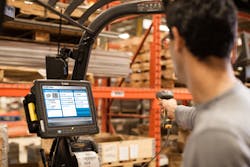Four Strategic Focus Areas To Build Warehouse Resiliency
When it comes to e-commerce and fulfillment, the on-demand economy has driven customers’ expectations sky-high. It has also exposed many of the challenges small and medium-sized warehouse operators face as they strive to compete in a hyperconnected world. Though many small and medium-sized businesses (SMBs) realized diminished revenues in 2020—or even ceased operations—others accelerated automation plans to keep up, succeed, and prosper. Many of the rebounded businesses prioritized investments in technology digitalization and automation to optimize outbound operations.
Enhancing Performance and Productivity
Warehouse operators are well aware of the power of technology and automation. According to Zebra Technologies' Warehousing Vision Study conducted pre-pandemic, 77% of warehouse operators agreed they needed to modernize operations but admitted they were slow to implement new devices and technology.
Recent market disruptions, however, have inspired manufacturers, warehouses, and other logistics businesses to innovate. In fact, the McKinsey Global Institute found that improved efficiency through digitalization and automation could account for up to 60% of potential growth in annual productivity.
The technology and solutions that can help deliver best-in-class customer service are essentially the same as those used by larger enterprises, just adapted for the needs of a smaller volume business as it scales. This chaotic era illustrates the importance of agility as new needs arise.
Building a Resilient Warehousing Operation
If change is the only constant, the pandemic will not be the last unforeseen event throwing global supply chains off course. SMBs have learned it is vital to gain control of their operations and quickly respond to changing market conditions to minimize disruptions to end customers. Having visibility in the supply chain helps them know the exact location and status of all items, including inventory, assets, and people, so they can proactively adjust strategies and tactics when needed.
As consumer confidence rebounds and the holiday shopping season approaches, many SMBs are focusing on increasing resilience and agility in their outbound operations and starting with digitalization. To be most successful, the focus should remain squarely on these steps of the order fulfillment journey within the warehouse: picking, packing, staging/loading, and delivery.
Step 1: Save Picking Time on the Warehouse Floor
According to Georgia Tech, picking accounts for 63% of all operating costs in a typical warehouse. It is also one of the most time-intensive processes and has one of the highest rates of employee turnover, leading to sunk costs and time in hiring and training new front-line workers.
Enterprise mobile devices and apps can help automate many warehouse workflows, speed up fulfillment, and maximize productivity. Additional investment in hands-free wearable devices can improve employees’ picking experiences, as they’ll be able to quickly and safely grab items or operate forklifts. If the devices are synced with the right task management software and augmented reality apps, workers will know exactly where to go and what to grab to fulfill each order—no time or energy wasted. As the business scales, operators can consider integrating technologies such as autonomous mobile robots (AMR) or collaborative robots (cobots) that can operate alongside workers on the floor to help them move picked items to packing stations.
Step 2: Getting Orders Packed Right the First Time, in Less Time
In an age where warehouse operations extend from manufacturing facilities to micro fulfillment centers, modernizing the packing process becomes more critical in ensuring customer satisfaction.
Handheld or wearable devices, powered by intelligent workflow management software, help instruct front-line workers on the ideal materials to pack each product or pallet. In addition to protecting the merchandise or cartons from being damaged or compromised as they travel through the fulfillment journey, it also helps employees trim time spent on decision making. During this point in the process, barcoded labels and radio frequency identification (RFID) tags should also be added to packages and pallets. This helps ensure critical components have the right order tracking for warehouse operators, customers, and even end-user consumers to locate their items at any point in the shipping process. This level of visibility helps reduce lost items and inventory shortages as operators can verify orders before they are sent out and also access inventory levels as needed.
Step 3: Getting Orders Out the Door and Headed in the Right Direction
Optimizing the staging process helps prevent delivery mistakes downstream that can create disruption for retail partners and result in customer dissatisfaction. Equipped with multifunctional handheld mobile devices, quality control inspectors and logistics managers can use barcode scanners or RFID readers to ensure each labeled package or palletized order is complete and loaded onto the right trailer with the right carrier.
Zebra’s Warehousing Vision Study also found that 43% of organizations plan to implement real-time location systems (RTLS) for a bird’s-eye view of operations and cross-checking the location of assets and goods across the warehouse. However, every warehouse or distribution center operator should be using RTLS systems to see what’s coming in and out of the warehouse, especially now that they are more affordable and accessible than ever before. The more efficient the outbound supply chain, the easier smaller warehouses can scale up as demand increases.
Installing fixed RFID readers at loading dock doors can automate outbound inventory tracking and help operators avoid the costs associated with mis-shipping. Camera and sensor-based solutions can also provide visibility into trailer or container utilization. No one can afford to ship air, especially with order volumes high and demand for delivery drivers even higher.
Step 4: Seeing Orders Through Delivery
Goods may have left the warehouse, but they are still on warehouse operators’ books—at least until they arrive at the next destination. There are a host of technology solutions that can be used to help warehouse staff, delivery drivers, and customers track order movements, whether transported by truck, plane, boat or rail. GPS, electronic logging devices, mobile computers, and other wirelessly connected solutions can be added to shipments and the vehicles transporting them to maintain real-time visibility into departure and arrival times, as well as current locations. If something is running behind, supply chain partners and customers can be alerted. Upon arrival at the distribution center, store or customer door, a quick barcode scan or RFID tag read can confirm order receipt.
Now Is the Time to Digitalize
Years of tech evolution have been crammed into one short but very accelerated period of adoption, making it possible to build more resilient warehouse operations. However, modernization is a journey, and each SMB will move at its own pace. Small and growing warehouses just need to be sure consumer demand and competitor performance don’t outpace their own innovation and performance gains.
To learn how the right solutions can help SMBs better meet customer demands and build long-term resilience, click here.
About the Author

Amanda Honig
SMB Industry Lead, Zebra Technologies
Amanda Honig is currently a Regional Portfolio Manager for Zebra in North America. In this role, she leads the strategy and roadmap for enterprise mobile computing by identifying investment priorities and ensuring product and solution requirements by use case, all while representing the voice of the customer across the region and providing strategic sales support. Leveraging her genuine passion for helping customers get the most out of our products, Amanda also serves as a small and medium-sized business (SMB) Industry Lead. She is one of many creative, tech-savvy advisors helping Zebra connect SMBs with breakthrough technology solutions that advance the way they work.
Amanda has more than 14 years of experience within the B2B technology industry and has held several leadership roles. She obtained an MBA from Long Island University and a Bachelor of Science in Business Administration from the University at Buffalo. Amanda is a super-curator who can disentangle complex technologies and apply them to real-world situations—especially for small and growing businesses.
Previously, she was the Sr. Manager, Manufacturing and Transportation & Logistics Vertical Marketing where she was responsible for the development of go-to-market strategy and priorities for both. She also served as the Americas Portfolio Marketing Manager for enterprise mobile computing at Zebra and as a Global Product & Solutions Marketing Manager at Motorola Solutions.


